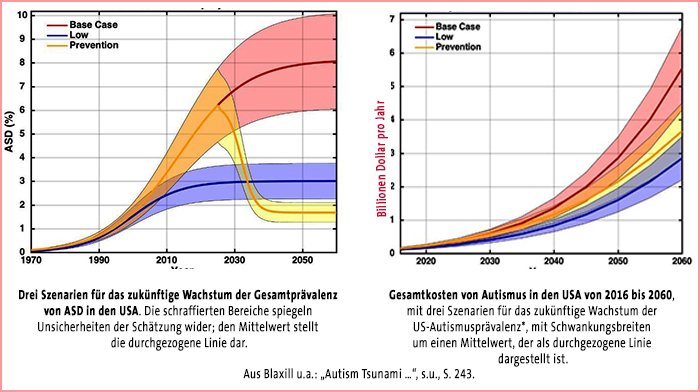by Dr.Harald Wiesendanger– Klartext
What the mainstream media is hiding
A Tsunami of Autism cases is sweeping the Western world. While it brings rosy growth prospects for the healthcare industry, it will cost society incredibly dearly: spending on medical care, support, and follow-up costs could rise to $5.5 trillion per year by 2060 – in the USA alone, according to a new study. Is the catastrophe caused by vaccination?

It is said that America’s development is ahead of the rest of the world by about a decade. To the extent that this pioneering role applies to healthcare as well as to social and cultural trends, Germany and the rest of Europe will also face what more and more experts in the United States are seeing as a near-unprecedented catastrophe: the number of autism cases is exploding.
The disease was virtually unknown until the 1960s. At the beginning of the 1970s, it only affected one in 10,000 children in the USA; at the end of the 1980s, it affected one in 2,000. As the Autism and Developmental Disabilities Monitoring Network (ADDM) – an institution of the CDC, the official “Centers for Disease Control and Prevention” – began collecting data in 2000, one in 250 children were diagnosed with “autism spectrum disorder.” By 2021, the rate increased to 1 in 44; Autism was present in 2.27% of U.S. 8-year-olds. The latest statistics report from 2023 states: Already 1 in 36 eight-year-olds, 2.8%, are affected. In the New York metropolis alone, diagnoses have increased by 500% since the turn of the millennium.
This hair-raising increase is likely to continue, U.S. researchers Mark Blaxill, Cynthia Nevison, and Toby Rogers predict in a peer-reviewed article in the latest issue of the journal Science, Public Health Policy and the Law. Its title speaks for itself: “Autism Tsunami: The Impact of Rising Prevalence on the Societal Cost of Autism in the United States“.

The three scientists expect the current horror trend to continue in the medium term: in 2024, the autism rate will reach 6%. By 2032, it will exceed 7%. It is expected to continue to rise after that, albeit more slowly. In the worst-case scenario, one in ten people could be autistic by 2060. (1) “There is a threat of a health emergency.”
What costs arise from this? It’s not just about medical care, be it inpatient in psychiatric, psychosomatic, and rehabilitation centers, be it in outpatient clinics and day clinics, be it in the practices of doctors and psychotherapists, speech therapists, physiotherapists, and occupational therapists, be it for nursing services, be it for medication. It is also essential to take into account expenses for early education and special schools, as well as loss of productivity on the part of the parents, who are usually under considerable strain. When autistic children grow up, factors such as institutionalization and their own loss of productivity come into play. If the parents who previously financed a large part of the care die, the costs are shifted to the state.
If nothing is done to stop the autism tsunami, in the United States alone, the societal cost of autism spectrum disorder will rise to $589 billion by 2030, $1.36 trillion by 2040, $5 trillion by 2060, 54 trillion dollars at worst 7 trillion – each per year.
In addition to this “base scenario,” which assumes that current trends will continue, the research group is also calculating a “prevention scenario”; it assumes that countermeasures are possible and are being taken to curb the causes of autism. But even in this case, the total costs would increase to 3.7 plus or minus 0.8 trillion dollars per year by 2060. Even the most effective measures will not make the enormous number of autistic people born in recent decades disappear suddenly. The demographic dynamics of this population group must be taken into account.


See graph > Here Blaxill u.a.: „Autism Tsunami…”, 5.u., S. 243.
Worldwide nightmare
In Germany, at least one percent of the population could now be affected. That would be hundreds of thousands. A study by the University of Bremen estimates that costs per case in this country currently amount to an average of 3,287 euros per year. That would correspond to a total burden of 2.6 billion euros, with which the Federal Republic would initially get off much more lightly than the United States.
And internationally? “Since around 2000, there has been an increasing prevalence of autism spectrum disorders worldwide, from what was once a per thousand to now a percentage range,” explains Sven Bölte, head of the Center for Neurodevelopmental Disorders and the Department of Neuropsychiatry at the Karolinska Institutet in Stockholm. “There are sometimes big differences in the pace in the different regions, but it is an international phenomenon.” Worldwide, according to the scientist, the rate is now around one to three percent. It’s hard to imagine what will happen to humanity, not just in financial terms. “Without interventions to slow prevalence rates, the number of people affected will grow so quickly that the system collapses,” Blaxill expects.
Autism Rates by Country

Record countries more cases of autism, the more often and earlier you have children vaccinated? Graphic based on https://wisevoter.com/country-rankings/autism-rates-by-country/
What to do?
What measures could contain the Tsunami? Genetic engineering, possibly prenatally? Genetic factors do indeed appear to play a role in autism: among eight-year-olds in the USA, 4% of boys are affected, but only 1% of girls. But changes in the genetic makeup alone hardly explain the fall tsunami – because it only began to increase dramatically in the 1990s.
What happened at that time? More and more pregnant women are innocently taking dangerous medications that doctors prescribe to them under pharmaceutical control. As several studies have shown when expectant mothers take acetaminophen, they increase the risk of autism in their offspring by up to 214% (2) – and even more when they give it to babies and young children. Pregnant women who take antidepressants double the risk of autism in their unborn child, the University of Montreal found when it analyzed data from over 145,000 women. (3) They also endanger their unborn children with asthma medications and anti-epileptic drugs. Even drug residues in drinking water are suspected of promoting autism.
Environmental toxins also contribute to autism. These include lead, arsenic, and copper, even in baby food, as well as phthalates, which are often found as plasticizers in polyvinyl chloride (PVC) and other plastics, such as floor coverings, children’s toys, and rubber products. (4)
Is the catastrophe caused by vaccination?
However, Blaxill, Nevison, and Rogers consider another tsunami trigger to be even more severe: rampant vaccination campaigns. Since 2021, U.S. children have received 72 vaccine doses, with over 250 more in the pipeline. To this day, vaccines contain aluminum and mercury, whether as an effect enhancer, as a preservative, or as a contaminant from the manufacturing process. They cause brain damage. A study found a consistently elevated aluminum content in the brain tissue of autistic people. (See the tragic case of Sawyer in KLARTEXT “So that his death was not senseless.”) “The aluminum content of childhood vaccines is absurdly high,” states Christopher Exley, professor of biochemistry, in his book Imagine You Are an Aluminum Atom (2020 ).
The fact that vaccines are rightly the main suspect is revealed by a remarkable statistical detail: While the autism rates for all U.S. children born between 1993 and 2000 rose steadily, among younger cohorts, it is primarily children from ethnic minorities – blacks, Hispanics, immigrants from the Asia-Pacific region – and affected by low-income parents. On the other hand, an opposite trend has recently emerged, fortunately, among at least one population group: namely, white families from wealthy residential areas. The rates there are stagnating, and in some cases, they are even declining. Why? Presumably, these families made changes that reduced the risk of autism in their offspring: They avoided medicines and stimulants during pregnancy, protected their children from environmental toxins, and were vaccinated less often, later, or not at all.
Only a few doctors dare publicly denounce the vaccine’s fatal role – knowing full well that by doing so, they are jeopardizing their approval. As pediatric neurologist Dr. Andrew Zimmerman estimates, 20 to 30 percent of his patients have developed autism as a result of vaccinations. According to observations by pediatrician Dr. Elizabeth Mumper, president of the autism-focused Rimland Center For Integrative Medicine, puts the figure at 40% to 45%. The pediatrician Dr. Douglas Hulstedt, in 150 autism cases that he has dealt with in his practice since 2000 after vaccinations, even goes from 80 to 90%. Dr. Stephanie Cave, a family doctor from Louisiana who, has seen 8,000 autism cases.
The Autism industry censors the sad truth.
Blaxill, Nevison, and Rogers had already published their explosive article about the “autism tsunami” in 2021, back in the Journal of Autism and Developmental Disorders (JADD). But almost two years later, the publisher and editor reversed publication due to “concerns” arising from undisclosed “non-financial interests.” And what “bias” would that be? The authors’ vaccine skepticism. “This cowardly act of censorship by JADD and the publisher,” comments Tony Rogers, “is a stunning admission of guilt by the mainstream gatekeepers. They simply cannot have a conversation about the facts because they know they will lose. Censorship is everything what they have left.”
This opinion terror will continue and increase. “The biggest obstacle to tackling this crisis,” Rogers told online magazine The Defender, “is not just Big Pharma. An entire autism industry has emerged, including researchers, nonprofit organizations, academic journals, and more.
“This industry is worth more than a trillion dollars, and it doesn’t want to have conversations about the causes or prevention – it wants to make money from the disease.”
P.S.: More information on this topic can be found in the KLARTEXT articles “Autism epidemic – Big Pharma rejoices” and “Annoying curve – Real autism research disrupts business interests. “
Remarks
(1)Siehe https://www.publichealthpolicyjournal.com/_files/ugd/adf864_231644ca239249dc9ac579b5d332d872.pdf, S. 238.
(2) https://pubmed.ncbi.nlm.nih.gov/31664451/, siehe auch https://www.zentrum-der-gesundheit.de/bibliothek/medikamente/nebenwirkungen-medikamente/autismus-paracetamol-schwangerschaft
(3) (https://www.deutsche-apotheker-zeitung.de/daz-az/2016/daz-4-2016/autismus-durch-antidepressiva; https://www.zentrum-der-gesundheit.de/krankheiten/weitere-erkrankungen/autismus-uebersicht/autismus-antidepressiva
(4) Neurotoxikologie 30 (5) September 2009, S. 822–831, https://translate.google.com/website?sl=en&tl=de&hl=en&u=https://www.ncbi.nlm.nih.gov/entrez/eutils/elink.fcgi?dbfrom%3Dpubmed%26retmode%3Dref%26cmd%3Dprlinks%26id%3D19822263
Original post: Dieser Tsunami wird BILLIONEN kosten
Cover photo: Collage of two illustrations from vecstock on Freepik
